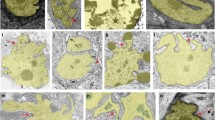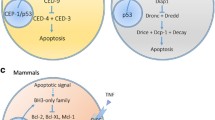Abstract
Apoptosis is a morphologically distinct form of programmed cell death that plays important roles in development, tissue homeostasis and a wide variety of diseases, including cancer, AIDS, stroke, myopathies and various neurodegenerative disorders (see for review). It is now clear that apoptosis occurs by activating an intrinsic cell suicide program which is constitutively expressed in most animal cells, and that key components of this program have been conserved in evolution from worms to insects to man. Genetic studies of programmed cell death in experimentally highly accessible invertebrate model systems have provided important clues about the molecular nature of the death program, and the intracellular mechanisms that control its activation. This review summarizes some of the key findings in this area, but also touches on some of the many unresolved questions and challenges that remain.
Similar content being viewed by others
Author information
Authors and Affiliations
Rights and permissions
About this article
Cite this article
Bergmann, A., Agapite, J. & Steller, H. Mechanisms and control of programmed cell death in invertebrates. Oncogene 17, 3215–3223 (1998). https://doi.org/10.1038/sj.onc.1202586
Published:
Issue Date:
DOI: https://doi.org/10.1038/sj.onc.1202586
- Springer Nature Limited
Keywords
This article is cited by
-
Novel roles of apoptotic caspases in tumor repopulation, epigenetic reprogramming, carcinogenesis, and beyond
Cancer and Metastasis Reviews (2018)
-
The unconventional myosin CRINKLED and its mammalian orthologue MYO7A regulate caspases in their signalling roles
Nature Communications (2016)
-
Coated chitosan nanoparticles encapsulating caspase 3 activator for effective treatment of colorectral cancer
Drug Delivery and Translational Research (2015)
-
Can’t live without them, can live with them: roles of caspases during vital cellular processes
Apoptosis (2009)
-
Foxo and Fos regulate the decision between cell death and survival in response to UV irradiation
The EMBO Journal (2007)




